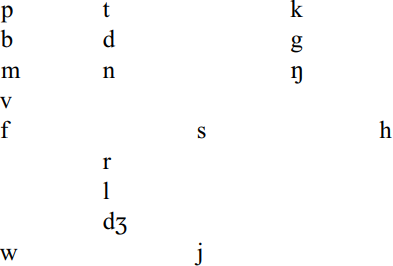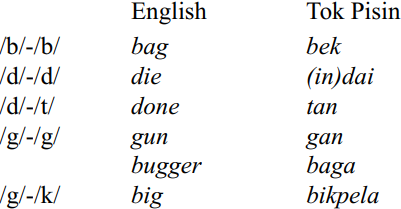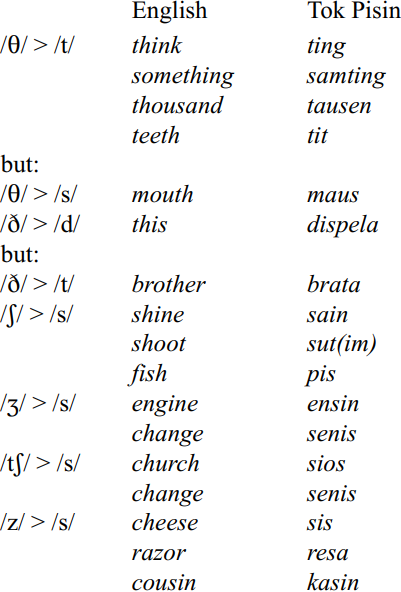


 Grammar
Grammar
 Tenses
Tenses
 Present
Present
 Past
Past
 Future
Future
 Parts Of Speech
Parts Of Speech
 Nouns
Nouns
 Verbs
Verbs
 Adverbs
Adverbs
 Adjectives
Adjectives
 Pronouns
Pronouns
 Pre Position
Pre Position
 Preposition by function
Preposition by function 
 Preposition by construction
Preposition by construction
 Conjunctions
Conjunctions
 Interjections
Interjections
 Grammar Rules
Grammar Rules
 Linguistics
Linguistics
 Semantics
Semantics
 Pragmatics
Pragmatics
 Reading Comprehension
Reading Comprehension|
Read More
Date: 2024-03-20
Date: 22-2-2022
Date: 2024-07-09
|
The following are the basic contrasting consonantal phonemes described in Mihalic (1971):

Note that this is identical to the inventory provided by Crowley for Bislama (this volume) apart from the inclusion of the affricate /ʤ/. The consonants are generally close to their IPA values.
Laycock’s (1985) core inventory also identifies the above phonemes, but in addition lists six pre-nasalized stop clusters: /mp, nt, ŋk, mb, nd/ and /ŋk/ . Their inclusion is justified on the basis that they do not permit epenthetic vowels. However, four fricatives /f, v, ʃ, Ʒ/ are included only parenthetically as of marginal use. He observes that these fricatives may be used contrastively only in heavily Anglicized speech.
The great majority of Tok Pisin lexical items are ultimately derived from English, and a number of correspondences between English sources and Tok Pisin words can be demonstrated. A number of these correspondences are listed in Laycock (1985: 296). The phonemes /p, t, k, s, m, n, ŋ, r/ and /y/ are generally unchanged, as in the following, all shown in initial position:

Other phonemes in the core Tok Pisin inventory also present in English may be variably represented. Voiced stops, for example, may appear as either voiced or unvoiced in Tok Pisin in initial and medial position, but always devoiced in final position:

Laycock does not produce any examples for English /b/ equivalent to Tok Pisin /p/, and there are only one or two very low frequency variants in my corpus (Smith 2002) such as panara for banara ‘bow’.
Although the phoneme /v/ is widely used in words such as vilis ‘village’, it may variably be replaced by /f/ in words such as faif/faiv ‘five’. Similarly, /ʤ/ , which appears in initial place in words such as joinin ‘join’ and Jun ‘June’, often becomes /s/ in medial and final position, for example jasim ‘to judge’ and bris ‘bridge’.
Other English consonants not normally found in Tok Pisin may correspond as follows:

The glottal fricative /h/ is variably present on words where /h/ is present in the English etymon. In what appears to be a case of hypercorrection, /h/ may also be added where none is present (ø) in English:

Of the six pre-nasalized stop clusters described by Laycock, all are equivalent to their English counterparts, except for the English /nʃ/ and /nƷ/ , which are rendered in Tok Pisin as -is in final position in winis ‘winch’ and senis ‘change’. However, the cluster is retained with the substitution of /s/ in medial position in ensin ‘engine’.
|
|
|
|
دراسة يابانية لتقليل مخاطر أمراض المواليد منخفضي الوزن
|
|
|
|
|
|
|
اكتشاف أكبر مرجان في العالم قبالة سواحل جزر سليمان
|
|
|
|
|
|
|
اتحاد كليات الطب الملكية البريطانية يشيد بالمستوى العلمي لطلبة جامعة العميد وبيئتها التعليمية
|
|
|